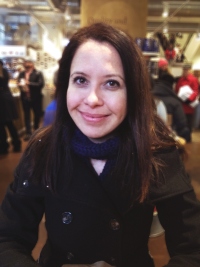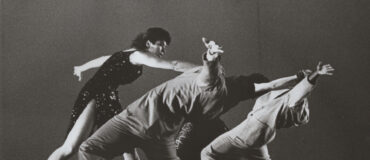By Daina Coffey
Daina Coffey is Dance/USA’s second Dance Archiving & Preservation Fellow. Her Fellowship, which ran from August-December 2018, was hosted by the Chicago Dance History Project, and her practicum site was Joel Hall Dancers. Read more about the Fellowship program here and read her first, second, and fourth blog posts.
December 19, 2018: The Joel Hall Dancers Legacy Exhibit: Part 2
In my previous post, I shared the process of curating an exhibit for the Joel Hall Dancers and Center’s (JHDC) “Legacy Concert” through my role at the Chicago Dance History Project (CDHP). In this post, I will continue in that vein, delving more deeply into how we conceptualized the exhibit, how we attempted to realize our vision, and what comes next.

Interactive objects and documents table
A key concept of our exhibit was the idea of the archive itself. We wanted our audience to think about archives and the role they play in their own lives. The goal was for the exhibit to have multiple layers—it wasn’t just going to be photos plastered on the wall (although that in itself has value). We wanted the work we do at CDHP—uncovering and making accessible previously unknown dance histories—to translate into this exhibit. In other words, we considered the archive as a process, as something interactive, and we tried to integrate these ideas into the exhibit.

Index card with question posted on exhibit panel.
With significant help from CDHP Executive Director Jenai Cutcher and board member Elizabeth Liebman, we designed a program for the exhibit, which offered some ideas and posed some questions about the makeup of a dance archive. We asked simple questions about what constitutes an archive, who decides what goes in it, and how a dance archive is distinct. We also suggested that a dance archive consists of “bodies, objects, spaces, memories, and communities”—all concepts we tried to incorporate into the exhibit itself (without being too heavy handed about it). The purpose of this program was to set a tone for the exhibit—and to give those who were interested some food for thought as they journeyed through.
However, we also wanted to create an interactive exhibit. So we set up a table with objects and documents from the JHDC dance archive and posed a series of questions.

Back of index card with audience responses.
The objects included a mask from “Y2 Day,” a hat from “El Gato Negro,” dance notes, a lighting plot, a program, and a dance studio sign-in sheet from 1976. We asked questions such as “What kinds of relationships do you think people had (or have) with these items?” and “Why do some documents and objects become valuable while others become disposable?” Onlookers were free to examine the materials on the table and to discuss them with their companions as they (hopefully) considered the questions we posed.
We also prompted our audience to look carefully at the 1976 sign-in sheet, which included Hall’s signature along with other prominent dancers from that period. We asked them to put themselves in the place of one of those dancers. “What was their world like?” we asked. “What might they have been thinking and experiencing at that particular moment?” In other words, we attempted to transport our audience back into time and to get them to consider another world—all through the use of the dance archive.

Exhibit visitor writing response on index card. All photos courtesy of Chicago Dance History Project.
To take our interactive theme even further, we wrote questions on large index cards and posted them on each exhibit panel, inviting onlookers to write their responses on the back of each card. We asked questions such as, “What clues do these costumes give us about the time and context of the performance?”; “How can we recreate a dance performance when its archive no longer exists?”; and “How is a performance archived in the body of a dancer?” To our delight, many people eagerly shared their answers. Our plan is to digitize these cards and add them to the dance archive.
And this leads me to our next task: curating a digital version of the JHDC exhibit and, more broadly, developing, organizing, and maintaining a comprehensive digital dance archive. The act of curating (or better yet, choreographing) the JHDC exhibit taught us a lot about how we might envision the digital exhibit.We’re imagining an interactive digital project and which continues to expand our goal of contributing to the dance archive as we work simultaneously to preserve it and make it readily accessible to current and future users. We view the archive as a living, breathing, dancing thing and we want our digital exhibit to reflect that vision.
 Daina Coffey is a Ph.D. Candidate studying U.S. history at the University of Chicago, where her teaching and research focuses on race, gender, and capitalism as well as urban and legal history. Deeply interested in digital preservation and records management, issues of accessibility, and curatorial practices, she has worked at a number of archives including the Bancroft Library at U.C. Berkeley, the Seaver Center for Western History Research at the Natural History Museum of Los Angeles, and the Special Collections and Research Center at the University of Chicago. Daina is thrilled to develop her archival skill set through working with local artists and dance-legacy materials at the Chicago Dance History Project this fall.
Daina Coffey is a Ph.D. Candidate studying U.S. history at the University of Chicago, where her teaching and research focuses on race, gender, and capitalism as well as urban and legal history. Deeply interested in digital preservation and records management, issues of accessibility, and curatorial practices, she has worked at a number of archives including the Bancroft Library at U.C. Berkeley, the Seaver Center for Western History Research at the Natural History Museum of Los Angeles, and the Special Collections and Research Center at the University of Chicago. Daina is thrilled to develop her archival skill set through working with local artists and dance-legacy materials at the Chicago Dance History Project this fall.
____
We accept submissions on topics relevant to the field: advocacy, artistic issues, arts policy, community building, development, employment, engagement, touring, and other topics that deal with the business of dance. We cannot publish criticism, single-company season announcements, and single-company or single artist profiles. Additionally, we welcome feedback on articles. If you have a topic that you would like to see addressed or feedback, please contact communications@danceusa.org.
Disclaimer: Opinions expressed in guest posts do not necessarily represent the viewpoints of Dance/USA.




